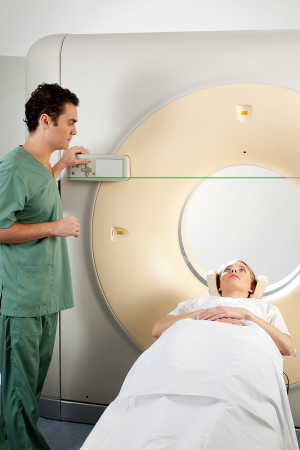by
John R. Fischer, Senior Reporter | September 21, 2017

Children undergoing CT scans for head
injuries could be overexposed to
radiation, increasing their risk of
developing cancer
Children brought to the ER for head injuries may be at risk right there for another serious issue – overexposure to radiation from CT scans.
That’s why the N.J. Council of Children’s Hospitals and the Institute for Quality and Patient Safety at the New Jersey Hospital Association (NJHA) have teamed up to form the Safe CT Imaging Collaborative, to assess and standardize protocols for head CT scans among children and to educate the public about the risks and benefits of CT imaging.
“If you look at the rate of CT scans and children seen and released in emergency rooms, there was a wide range,” Dr. Aline Holmes, senior vice president of clinical affairs at NJHA, told HCB News. “Some hospitals didn’t do many and some hospitals did a lot. We sent the data out to each individual hospital and asked that they engage with us to better understand what was going on with CT scans in children and why there was a wide variation even among systems.”



Ad Statistics
Times Displayed: 172815
Times Visited: 3130 For those who need to move fast and expand clinical capabilities -- and would love new equipment -- the uCT 550 Advance offers a new fully configured 80-slice CT in up to 2 weeks with routine maintenance and parts and Software Upgrades for Life™ included.
The use of one CT scan equals approximately 200 chest x-rays, building up the amount of radiation that a child is exposed to over his or her lifetime and putting them at risk for developing cancer. Approximately 50 percent of children who visit emergency departments with a head injury undergo a CT scan, even though CT scans are not necessary for minor head injuries, according to
NJHA's Institute for Quality and Patient Safety.
The collaborative started last fall to determine standards for when CT scans are necessary and what the proper radiation dosage should be for children.
Information was collected on the use of CT scans for children under 17 with head injuries who were seen and released from the emergency room in 2015 and 2016 at all 71 acute hospitals throughout New Jersey. The results showed a wide variation in the number of scans performed at each.
Following the assessment of the data, the collaborative adopted clinical observation criteria and an algorithm from the Pediatric Emergency Care Applied Research Network (PECARN) to determine when imaging should be allowed.
NJHA issued laminated cards with the algorithm printed on them to emergency room physicians and nurses across the state. Members of the collaborative also joined NJHA in a number of educational programs on safe CT practices.
In the last year, the collaborative has recorded a reduction of 956 avoidable CT scans on children in New Jersey hospitals, a 25 percent decrease. Forty-seven hospitals in the state have promised to reduce the number of CT scans not warranted to lower exposure of ionizing radiation to children.
“We’re asking that they implement them voluntarily in all of our hospitals. We send out charts to put up in the emergency room,” said Holmes. “We gave out lanyards with the PECARN protocol for all the doctors and nurses in the emergency room. We’ve developed a patient-family plan on why baby CAT scanning or scanning on your child may not be such a good idea. We’re hoping that everyone will move toward this evaluation of PECARN for kids with minor head trauma.”
The collaborative has also issued a #ScanSmart toolkit developed by NJHA to help health care providers teach and inform parents, coaches, trainers and community members about the appropriate use of CT imaging.

